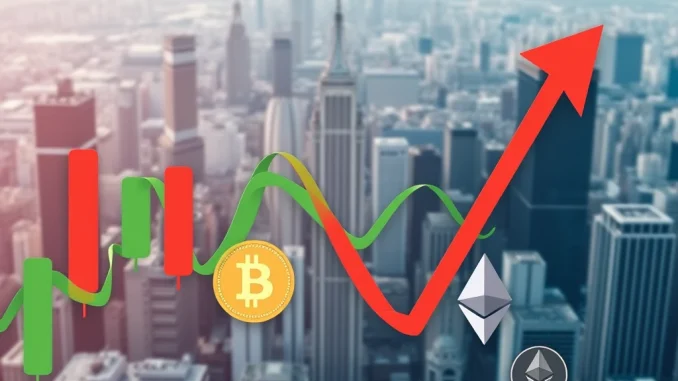
Ever felt like the market is speaking in riddles? Today’s close in the U.S. stock market is a perfect example of that. We saw a mixed bag of results from the major indexes – the S&P 500 and Dow Jones Industrial Average in the green, while the tech-heavy Nasdaq dipped into the red. For those of us in the crypto world, this seemingly disconnected dance of traditional markets can actually offer valuable clues and insights into the broader economic landscape and, consequently, our digital asset holdings. Let’s dive into what this stock market volatility means and why you should be paying attention, even if your primary focus is crypto.
Understanding the Mixed Signals from US Stock Indexes
The day concluded with a fascinating divergence among the key US stock indexes. It wasn’t a uniform upward surge or a downward spiral; instead, we witnessed a split performance that tells a more nuanced story about the current market conditions.
Here’s a quick snapshot of how the major indexes fared:
| Index | Change | Percentage Change |
| S&P 500 | Up | +0.55% |
| Nasdaq Composite | Down | -0.14% |
| Dow Jones Industrial Average | Up | +1.00% |
What does this mixed performance actually signify? It’s not as simple as ‘the market is up’ or ‘the market is down.’ Instead, it reflects a tug-of-war between different sectors and investor sentiments. The Dow, often seen as representing more traditional, value-oriented stocks, showed robust growth. Meanwhile, the Nasdaq, heavily weighted towards technology and growth stocks, faced headwinds. The S&P 500, a broader representation of the market, landed somewhere in between, showing a moderate gain.
Decoding Market Sentiment: What’s Driving the Divergence?
To truly grasp the implications, we need to understand the underlying market sentiment driving these movements. Several factors could be at play:
- Sector Rotation: Often in mixed markets, we see a rotation out of one sector and into another. Perhaps investors are shifting away from high-growth tech stocks, which have been market darlings for years, and moving towards sectors perceived as safer or offering better value in the current economic climate, like energy or financials which are more heavily represented in the Dow.
- Interest Rate Concerns: The shadow of potential interest rate hikes by the Federal Reserve always looms large. Growth stocks, particularly in the tech sector, are often more sensitive to interest rate increases because higher rates can erode the present value of their future earnings. This could be contributing to the Nasdaq’s underperformance.
- Economic Data and Expectations: Recent economic data releases and future expectations play a crucial role. Positive data might boost overall market sentiment, while concerns about inflation or slowing growth can create uncertainty and mixed reactions. The market is constantly trying to price in future economic scenarios.
- Geopolitical Events: Global events, from geopolitical tensions to international trade dynamics, can inject volatility into the markets. These events often create uncertainty, leading investors to reassess their risk exposure and investment strategies.
For crypto investors, understanding these drivers is crucial. Why? Because traditional markets, while seemingly different, are increasingly interconnected with the cryptocurrency space. Institutional investors often allocate capital across both asset classes, and broader economic trends impact all markets, albeit in different ways.
Investment Strategy in Uncertain Times: Lessons from the Stock Market for Crypto
A mixed stock market close serves as a powerful reminder of the need for a well-thought-out investment strategy, whether you are navigating traditional equities or the volatile world of crypto. Here are some key takeaways:
- Diversification is Key: Just as the mixed performance highlights the different sectors within the stock market, diversification is crucial in crypto. Don’t put all your eggs in one basket. Spread your investments across different cryptocurrencies and potentially even across different asset classes, including traditional stocks or commodities, if it aligns with your risk profile.
- Risk Management: Volatility is inherent in both stock and crypto markets, but crypto tends to amplify these swings. Develop a robust risk management strategy. This includes setting stop-loss orders, understanding your risk tolerance, and not investing more than you can afford to lose.
- Stay Informed, But Filter the Noise: In times of market uncertainty, information overload can be overwhelming. Stay informed about key economic indicators, market trends, and regulatory developments, but learn to filter out the noise and focus on credible sources and long-term perspectives.
- Long-Term Vision vs. Short-Term Swings: It’s easy to get caught up in day-to-day market fluctuations. However, successful investing, especially in volatile markets, requires a long-term vision. Don’t let short-term market swings derail your long-term investment goals.
Navigating Economic Uncertainty: Parallels Between Stock and Crypto Markets
The current mixed market scenario underscores a broader theme of economic uncertainty. This uncertainty is not confined to the stock market; it permeates the global economic landscape and inevitably impacts the crypto sphere as well.
Here’s how economic uncertainty manifests and connects both markets:
- Inflationary Pressures: Rising inflation is a major concern globally. It erodes purchasing power and can prompt central banks to tighten monetary policy (raise interest rates). Both stock and crypto markets react to inflation data and expectations, although their reactions might differ. Some view Bitcoin as an inflation hedge, while others see it as a risk asset that could suffer in a high-interest-rate environment.
- Global Growth Concerns: Slowing global economic growth, potentially exacerbated by geopolitical events, impacts corporate earnings and investor sentiment across the board. A slowdown in economic activity can reduce risk appetite, potentially leading to sell-offs in both stocks and crypto.
- Regulatory Landscape: The evolving regulatory landscape for cryptocurrencies adds another layer of uncertainty. Clarity and favorable regulations could boost crypto markets, while restrictive regulations could dampen enthusiasm. Traditional markets also face regulatory scrutiny, but the crypto space is still relatively nascent in this regard.
In times of economic uncertainty, both stock and crypto markets can experience heightened volatility. Understanding the macroeconomic factors at play and how they influence investor behavior is crucial for navigating these turbulent waters.
Conclusion: Embrace the Volatility, Stay Informed, and Adapt
The mixed close of the US stock indexes isn’t just a headline; it’s a valuable lesson in market dynamics and the interconnectedness of global finance. For crypto investors, paying attention to these signals from traditional markets is not about becoming a stock market expert, but about gaining a broader perspective on the economic forces that shape all investment landscapes.
Embrace the volatility, stay informed, refine your investment strategy, and adapt to the ever-changing market conditions. By understanding the nuances of both traditional and crypto markets, you can make more informed decisions and navigate the exciting, yet often unpredictable, world of digital assets with greater confidence. The mixed signals today might seem confusing, but within them lie valuable insights for those willing to decode them.



